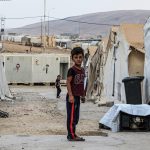The COVID-19 virus has left its mark on all aspects of life, paralyzing entire countries, closing borders, and pushing the global economy to the brink of collapse. At a time when it is spreading across continents and exposing the weaknesses of health systems in the richest and most advanced countries, it is important to realize that the novel coronavirus has exacerbated threats against the most vulnerable populations in other countries – especially in war-torn or post-conflict places where internally displaced people (IDPs) and refugees struggle to survive.
In this moment, those farthest from view and at the highest risk must not be forgotten. Urgent action at all levels must include providing key public health measures to combat the spread of COVID-19. It should also result in a concrete strategy to mobilize adequate resources that will ensure access to services for all those who need them.
Iraq is a case in point. Since announcing the first COVID-19 case on February 24, the Iraqi central government, as well as the Kurdistan Regional Government, have taken strict measures to stop the spread of the virus, including closing borders, suspending schools, and ordering people to stay home. Unfortunately, staying at home is not a viable option for Iraq’s more than 1,665,000 Internally displaced people, 24 percent (277,000) of whom are living in 67 camps across Iraq.
The 2014 ISIS invasion of large areas of Iraq – in which fighters of the self-declared “caliphate” targeted Yazidi and other ethnic and religious minorities, massacring men, abducting children, and kidnapping women and girls into sexual enslavement – forced hundreds of thousands of people to flee their homes to seek safety. People hastily left their livelihoods, their families, and communities to live in dire situations: in tents that afford no protection from extremely high summer temperatures nor from severe flooding in winter.
Dr. Nagham Hasan, a Yazidi gynecologist and activist who has dedicated her life to advocating for the rights of her people, warns that the teeming camps that house displaced Yazidi offer a prime setting for a COVID-19 outbreak: “These camps are overcrowded, large families live in each tent, and they share bathrooms and other facilities. There aren’t enough sanitary materials or enough medical supplies.”
Mr. Fadel al-Gharawi, a commissioner at The Iraqi High Commission for Human Rights (IHCHR), which has been monitoring the governmental response to COVID-19, cautions that camps for IDPs could become epicenters for the spread of the virus, as they lack proper health services as well as the possibility for residents to implement safe quarantines. The IHCHR also points out that IDPs have weakened immune systems due to the deteriorated health, humanitarian, and nutritional systems available to them.
Curfews and movement restrictions are also impeding the delivery of assistance in Iraq, including programming related to COVID-19 prevention, preparedness, and response, according to reports from the United Nations Office for the Coordination of Humanitarian Affairs and other humanitarian actors.
The looming threat of COVID-19 comes amidst a decrease in humanitarian funding to IDP communities following the retaking of the city of Mosul from ISIS control in July 2017. While the Iraqi federal government is implementing various measures in IDP camps, including disinfection campaigns, these are not commensurate with the magnitude of the impending public health crisis.
This is particularly true in cities like Dohuk, which borders the most conflict-affected areas in Iraq and saw the greatest influx of people seeking safety after the 2014 ISIS attacks. According to a humanitarian aid worker in Kurdistan, who asked for anonymity out of safety concerns: “Many international humanitarian NGOs have been leaving Dohuk, which hosts the largest number of IDPs, so the services they offer to these people are being reduced, even though it is not yet safe for them to return home. There is less food being distributed and few medical and other services, [and] there are fewer jobs in the camps or available nearby, so [people have] little income to purchase necessary materials to protect themselves from the coronavirus.”
The fear that COVID-19 could spread in camps is pervasive. Containing it will be challenging, given the difficulty of tracking, testing, and isolating suspected cases. Dr. Hasan explains: “Doctors and volunteers are working non-stop with whatever available capacities to help the communities in IDP camps. For now, we are working to produce masks locally and conducting awareness campaigns to explain to these communities what the symptoms are, how to wash hands, and how to maintain social distancing to the extent possible, in their unusual circumstances.”
But much more is needed. Now more than ever, it is crucial that the Iraqi government, the Kurdistan Regional Government, and the international community work together to recognize the risk COVID-19 poses to IDPs and collaborate to prioritize the health, both physical and mental, of the displaced. This coordination must include rearranging priorities and allocating budgets to rapidly respond to the needs of these communities, starting with providing water and basic cleaning and sanitary products and continuing with designing creative ways for IDPs to access services.
This pandemic is inherently indiscriminate and must be confronted with every tool in the public health and humanitarian arsenal. Multipronged and inclusive national and international efforts to respond to the coronavirus should be fully integrated into emergency response plans not only in Iraq, but in all conflict-affected countries.

